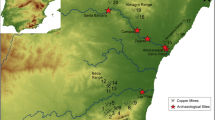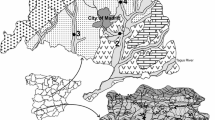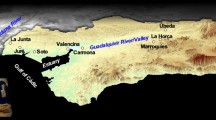Abstract
The purpose of this study is to investigate the differences in sources of discrete four zones that are represented by the lead isotope map of metal mines using galena samples. The lead isotope map has been constructed based on 119 galena samples from 38 metal mines in the southern Korean Peninsula, together with previously published data, using spatial and zoning distribution analysis. The spatial pattern of 206Pb/204Pb ratio shows relatively dense distribution with highest value at the northeastern region, while 207Pb/204Pb and 208Pb/204Pb ratios are the lowest at the southeastern region. These results indicate possible subdivision of the lead isotope maps based on geotectonic subdivisions and geographical locations of the Korean Peninsula. This subdivision has been checked by linear discriminant analysis (LDA). The range of lead isotopic composition for zone 1 has fairly homogeneous values (206Pb/204Pb = 18.156–18.591, 207Pb/204Pb = 15.482–15.644, and 208Pb/204Pb = 37.870–38.768), and are geographically similar to the Gyeongsang Basin. Lead isotopic compositions of zone 2 show the highest ratios (206Pb/204Pb = 18.625–20.483, 207Pb/204Pb = 15.708–16.068, 208Pb/204Pb = 37.734–40.463) in the southern Korean Peninsula, that are geographically corresponding to the Taebaeksan Basin and the northeastern Yeongnam Massif. Relatively lower values (206Pb/204Pb = 17.149–17.817, 207Pb /204Pb = 15.497–15.731, 208Pb /204Pb = 37.847–39.773) along the western Gyeonggi Massif are grouped as zone 4, while the rest of the areas, including the Okcheon metamorphic belt, most of the Gyeonggi Massif, and the Yeongnam Massif, might represent zone 3. The results clearly indicate the possible differences in the source reservoirs that are similar to the geotectonic provinces of the Korean Peninsula.
Similar content being viewed by others
References
Chang, B.U., 1997, A study on the lead isotopic compositions of Ore deposits and Igneous rocks in the Gyeongsang Basin, southeast Korea. Ph.D. Thesis, Seoul National University, Seoul, 100 p.
Cheong, C.-S., Kil, Y.-W., Kim, J.M., Jeong, Y.-J., and Im, C.B., 2004, Geochemical characteristics of Precambrian basement rocks in the Jukbyeon area, northeastern Yeongnam massif, Korea. Journal of Geological Society of Korea, 40, 481–499. (in Korean with English abstract)
Cheong, C.S. and Kim, N., 2012, Review of radiometric ages for Phanerozoic granitoids in southern Korean Peninsula. Journal of Petrological Society of Korea, 21, 173–192. (in Korean with English abstract)
Chough, S.K., Kwon, S.-T., Ree, J.-H., and Choi, D.K., 2000, Tectonic and sedimentary evolution of the Korean Peninsula: a review and new view. Earth-Science Reviews, 52, 175–235.
Chough, S.K. and Sohn, Y.K., 2010, Tectonic and sedimentary evolution of a Cretaceous continental arc-backarc system in the Korean Peninsula: new view. Earth-Science Reviews, 101, 225–249.
Cumming, G.L. and Richards, J.R., 1975, Ore lead isotope ratios in a continuously changing earth. Earth and Planetary Science Letters, 28, 155–171.
Doe, B.R. and Zartman, R.E., 1979, Plumbotectonics I, The Phanerozoic. In: Barnes, H.L. (ed.), Geochemistry of Hydrothermal Ore Deposits. Wiley Interscience, p. 22–70.
Gale, N.H. and Stos-Gale, Z., 2000, Lead isotope analyses applied to provenance studies. In: Ciliberto, E. and Spoto, G. (eds.), Modern Analytical Methods in Art and Archaeology. Wiley, p. 503–584.
Gerstenberger, H. and Haase, G., 1997, A highly effective emitter substance for mass spectrometric Pb isotope ratio determination. Chemical geology, 136, 309–312.
Gökce, A. and Bozkaya, G., 2005, Lead and sulfur isotope evidence for the origin of Inner Yaylasi lead-zinc deposits, Northern Turkey. Journal of Asian Earth Science, 26, 91–97.
Gulson, B.L., 1986, Lead isotopes in mineral exploration. Developments in Economic Geology 23, Elsevier, Amsterdam, 245 p.
Izenman, A.J., 2013, Linear discriminant analysis. In: Modern Multivariate Statistical Techniques. Springer Texts in Statistics, New York, p. 237–280
Jeong, Y.-J., Cheong, C.-S., Shin, D.B., Lee, K.-S., Jo, H.J., Gautam, M.K., and Lee, I.S., 2012, Regional variations in the lead isotopic composition of galena from southern Korea with implications for the discrimination of lead provenance. Journal of Asian Earth Science, 61, 116–127.
Kim, S.W., Park, S.-I., Jang, Y., Kwon, S., Kim, S.J., and Santosh, M., 2017, Tracking Paleozoic evolution of the South Korean Peninsula from detrital zircon records: implications for the tectonic history of East Asia. Gondwana Research, 50, 195–215.
Lee, H.K., Kim, S.J., Yun, H., Choi, W.C., Song, Y.S., and Itaya, T., 1993, K-Ar age of the Keumseongsan volcanic rocks and mineralization in the southeastern part of Euiseong, Gyeongdangbuk-Do, Republic of Korea. Journal of Korean Institution of Mining Geology, 26, 445–454. (in Korean with English abstract)
Mabuchi, H., 1985, The lead isotope systematics in Asia and near East. Grant Report to the Ministry of Education Science and Culture, Japan, No. 58540374–59540377, 19 p. (in Japanese)
Mukai, H., Tanaka, A., Fujii, T., and Nakao, M., 1994, Lead isotope ratios of airborne particulate matter as tracers of long-range transport of air pollutants around Japan. Journal of Geophysical Research, 99, 3717–3726.
O’Nions, R.K., Evensen, N.M., and Hamilton, P.J., 1979, Geochemical modeling of mantle differentiation and crustal growth. Journal of Geophysical Research Solid Earth, 84, 6091–6101.
Park, H.-I., Chang, H.W., and Jin, M.S., 1988, K-Ar ages of mineral deposits in the Taebaeg mountain district. Journal of Korean Institution of Mining Geology, 21, 57–67. (in Korean with English abstract)
Park, K.-H., Cheong, C.-S., Lee, K.S., and Chang, H.-W., 1993, Isotopic composition of lead in Precambrian granitic rocks of the Taebaeg area. Journal of Geological Society of Korea, 29, 387–395. (in Korean with English abstract)
So, C.-S., Shelton, K.L., Chi, S.-J., and Choi, S.H., 1988, Stable isotope and fluid inclusion studies of gold-silver-bearing hydrothermal vein deposits, Cheonan-Cheongyang-Nonsan mining district, Republic of Korea: Cheongyang area. Journal of Korean Institution of Mining Geology, 22, 149–164.
So, C.-S. and Yun, S.T., 1992, Geochemistry and genesis of hydrothermal Au-Ag-Pb-Zn deposits in the Hwanggangri mineralized district, Republic of Korea. Economic Geology, 87, 2056–2084.
Song, B.-Y., Ryu, J.S., Shin, H.S., and Lee, K.S., 2014, Determination of the source of Bioavailable Sr using 87Sr/86Sr Tracers: a case study of hot pepper and rice. Journal of Agricultural and Food Chemistry, 62, 9232–9238.
Stacey, J.S. and Kramers, J.D., 1975, Approximation of terrestrial lead isotope evolution by a two-stage model. Earth and Planetary Science Letters, 26, 207–221.
Thorpe, R.I., 1999, The Pb isotope linear array for volcanogenic massive sulfide deposits of the Abitibi and Wawa subprovinces, Canadian Shield. In: Hannington, M.D. and Barrie, C.T. (eds.), The Giant Kid Creek Volcanogenic Massive Sulfide Deposits. Western Abitibi Subprovince, Canada. Economic Geology Monograph, 10, p. 555–576.
Yun, S. and Silberman, M.L., 1979, K-Ar geochronology of igneous rocks in the Yeonhwa-Ulchin zinc-lead district and southern margin of the Taebaegsan basin, Korea. Journal of Geological Society of Korea, 15, 89–100. (in Korean with English abstract)
Zartman, R.E. and Doe, B.R., 1981, Plumbotectonics-the model. Tectonophysics, 75, 135–162.
Zartman, R.E. and Haines, S.M., 1988, The plumbotectonic model for Pb isotopic systematics among major terrestrial reservoirs-A case for bi-directional transport. Geochimica et Cosmochimica Acta, 52, 1327–1339.
Zhu, B., Li, X., and Liu, B., 1990, Three component mixing and four system recycling models for explaining Nd-Sr-Pb isotopic correlations of suboceanic and subcontinental mantles. Science China Chemistry, 33, 757–768.
Zhu, B., 1995, The mapping of geochemical provinces in China based on Pb isotopes. Journal of Geochemical Exploration, 55, 171–181.
Author information
Authors and Affiliations
Corresponding author
Rights and permissions
About this article
Cite this article
Jeong, YJ., Cheong, A.Cs. Lead isotope mapping of galena from base metal deposits in the southern Korean Peninsula. Geosci J 23, 235–252 (2019). https://doi.org/10.1007/s12303-018-0034-z
Received:
Accepted:
Published:
Issue Date:
DOI: https://doi.org/10.1007/s12303-018-0034-z




